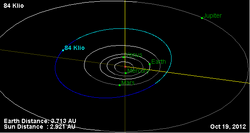Astronomy:84 Klio
 Orbital diagram | |
| Discovery | |
|---|---|
| Discovered by | Karl Theodor Robert Luther |
| Discovery date | August 25, 1865 |
| Designations | |
| (84) Klio | |
| Pronunciation | /ˈklaɪ.oʊ/[1] |
| Named after | Clio |
| Minor planet category | Main belt · Klio |
| Adjectives | Klionian /klaɪˈoʊniən/ Klioian /klaɪˈoʊ.iən/[2] |
| Orbital characteristics[3] | |
| Epoch December 31, 2006 (JD 2454100.5) | |
| |{{{apsis}}}|helion}} | 436.886 Gm (2.920 AU) |
| |{{{apsis}}}|helion}} | 269.828 Gm (1.804 AU) |
| 353.357 Gm (2.362 AU) | |
| Eccentricity | 0.236 |
| Orbital period | 1325.961 d (3.63 a) |
| Mean anomaly | 326.072° |
| Inclination | 9.334° |
| Longitude of ascending node | 327.651° |
| 14.690° | |
| Physical characteristics | |
| Dimensions | 79.16 km[3] |
| Mass | (5.47 ± 4.06) × 1017 kg[4] |
| Mean density | 2.08 ± 1.55[4] g/cm3 |
| Rotation period | 23.562 ± 0.001 h[3][5] |
| Geometric albedo | 0.053[3][6] |
| G[3] | |
| Absolute magnitude (H) | 9.32[3] |
Klio (minor planet designation: 84 Klio) is a fairly large and very dark main-belt asteroid. It was discovered by R. Luther on August 25, 1865, and named after Clio, the Muse of history in Greek mythology. The name Clio had previously been suggested by the discoverer of 12 Victoria, and that is the name B. A. Gould, editor of the prestigious Astronomical Journal, adopted for that asteroid, because of the controversy over the name Victoria. An occultation by Klio over a dim star was observed on April 2, 1997.
Photometric observations of this asteroid during 2007 at the Organ Mesa Observatory in Las Cruces, New Mexico were used to create a light curve plot. This showed a synodic rotation period of 23.562 ± 0.001 hours and a brightness variation of 0.21 ± 0.02 magnitude during each cycle.[5]
Perturbation
Perturbations of asteroid 52 Europa by 84 Klio suggest that 52 Europa would have a mass as high as 1.68×1020 kg.[7][8] But this would require Europa to have an unrealistic density of 10.6 g/cm3.[7] Further observations of Klio will be needed to properly refine the mass of both asteroid Europa and Klio.
References
- ↑ Noah Webster (1884) A Practical Dictionary of the English Language
- ↑ 'Clioian' in Rita Dandridge, ed. (2019) The Collected Essays of Josephine J. Turpin Washington, p. 176
- ↑ 3.0 3.1 3.2 3.3 3.4 3.5 "JPL Small-Body Database Browser: 84 Klio". https://ssd.jpl.nasa.gov/sbdb.cgi?sstr=84.
- ↑ 4.0 4.1 Carry, B. (December 2012). "Density of asteroids". Planetary and Space Science 73 (1): 98–118. doi:10.1016/j.pss.2012.03.009. Bibcode: 2012P&SS...73...98C. See Table 1.
- ↑ 5.0 5.1 Pilcher, Frederick (June 2008). "Period Determination for 84 Klio, 98 Ianthe, 102 Miriam 112 Iphigenia, 131 Vala, and 650 Amalasuntha". The Minor Planet Bulletin 35 (2): 71–72. doi:10.1016/j.pss.2012.03.009. Bibcode: 2008MPBu...35...71P.
- ↑ Asteroid Data Sets
- ↑ 7.0 7.1 Michalak, G. (August 2001). "Determination of asteroid masses". Astronomy & Astrophysics 374 (2): 703–711. doi:10.1051/0004-6361:20010731. Bibcode: 2001A&A...374..703M. https://www.aanda.org/articles/aa/full/2001/29/aa10228/aa10228.html.
- ↑ (High estimate for mass of asteroid Europa 0.851 / Mass of Ceres 4.75) * Mass of Ceres 9.43E+20 = 1.689E+20
External links
- 84 Klio at AstDyS-2, Asteroids—Dynamic Site
- 84 Klio at the JPL Small-Body Database
 |

